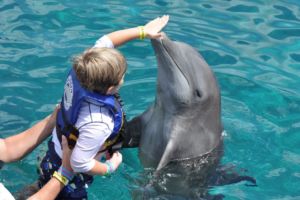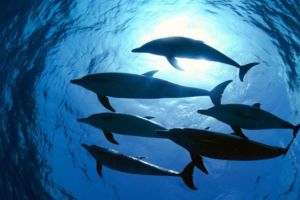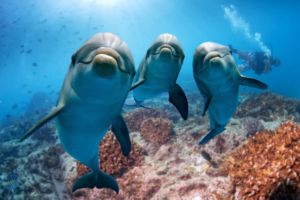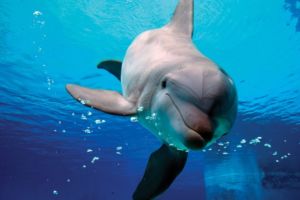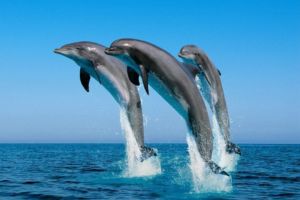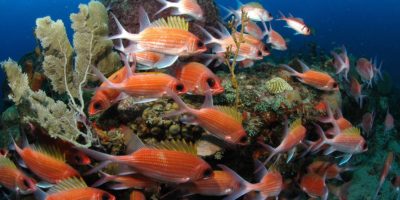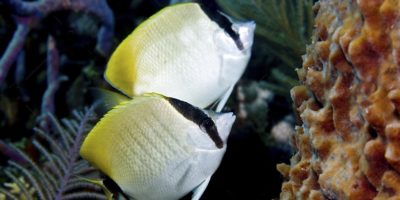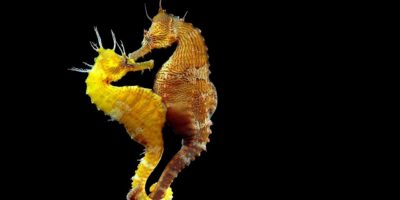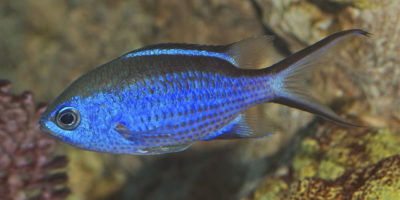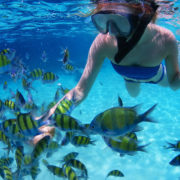Dolphins are the friendliest of all marine creatures, a favorite for photo ops and marine themed parks. They are a widely distributed and diverse group of aquatic mammals, belonging to the order Cetacea ( same as whales ). There are 40 extant species of dolphins, living in oceans and rivers. The most common species in the Caribbean are the Atlantic bottlenose and the Atlantic spotted dolphin.
Gallery
Distribution
The Atlantic spotted dolphin is endemic to the temperate and tropical areas of the Atlantic Ocean, including the Caribbean. About 20 years ago, only about 80 dolphins were in the Bahamas. Now, almost 200 dolphins are found there. On account of their similar appearance to other dolphins in their range, it is difficult to be sure of the Atlantic spotted dolphin’s population.
A conservative estimate is around 100,000 individuals. The bottlenose dolphin also inhabits warm oceans and tropical seas. Every now and then Sosua beach visitors see a group of dolphins entering Sosua Bay and get real close to the beach.
Human interaction
The species sometimes shows curiosity towards humans in or near water. They have been known to rescue injured divers by raising them to the surface. They do the same to help injured members of their own species. There is a report from New Zealand describing how a dolphin intervention helped four lifeguards that were approached by a great white shark.
The dolphins herded the swimmers together for 40 minutes as they swam to shore, preventing the shark from attacking. In marine – themed parks, humans swim with dolphins, though for some people this practice raises concern for the species due to stress to the animals in captivity.
Feeding Habits
Dolphins eat fish as the main item in their diet. They also eat mollusks, shrimps, squid and cuttlefish. They eat about 22 pound of fish a day. They work together to hunt when they find a shoal of fish, herding them towards the shore to maximize the harvest. They also can hunt alone, attacking bottom dweller species.
On Video:
Reproduction
Dolphins have genital slits on the underside of their bodies. Males can retract and conceal their penis through this slit. The female`s slit houses her vagina and anus. This ability to stow their reproductive organs allows for maximum hydrodynamics. During breeding season, males compete for access to females. Mating occurs belly to belly.
Dolphins have a gestation period of 12 months, and births can occur anytime of years, although peaks occur in warmers months. Usually a single calf in born, and rarely, there can be twins. Newborn dolphins are 2.6-4.6 ft long and weight 9-30 kg; Females have two mammary slits, each housing one nipple, one on each side of the genital slit. Females sexually mature at ages 5–13, males at ages 9–14. Females reproduce every 2-6 years.
Conservation
The bottlenose dolphin is not endangered. Their future is stable because of their abundance and adaptability. The Atlantic spotted dolphin is included in the Memorandum of Understanding Concerning the Conservation of the Manatee and Small Cetaceans of Western Africa and Macaronesia.
Sources:
- Types of Dolphin
- Dolphins World
- Encyclopedia Britannica
- National Geographic – Bottlenose dolphin
- Wikipedia – Bottlenose dolphins



